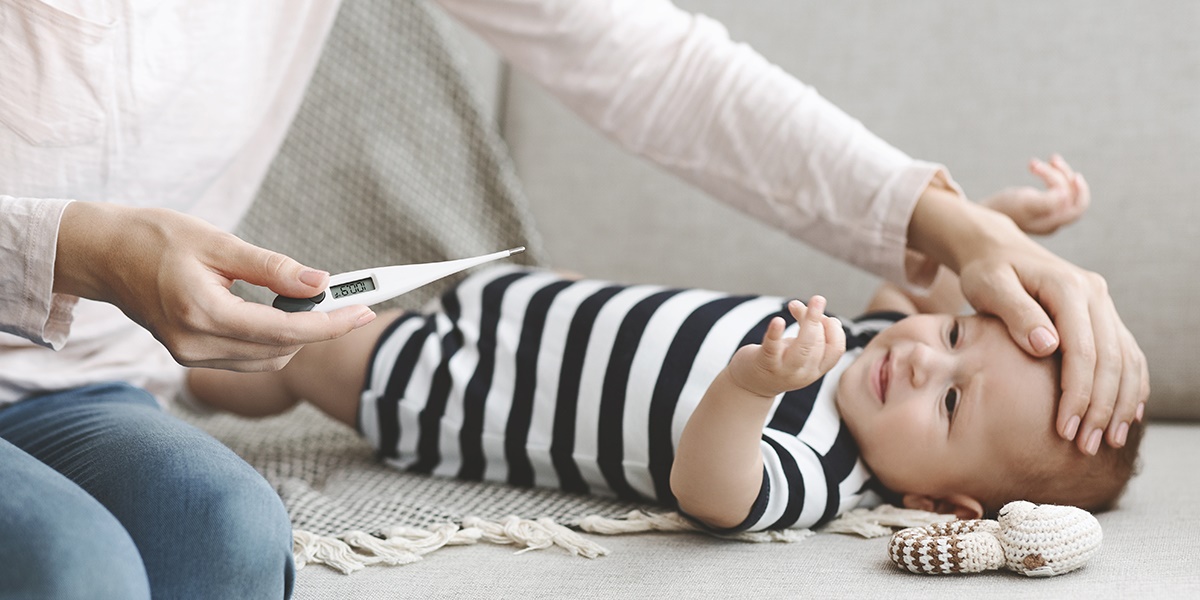
The first time you suspect your baby might be running a fever can make your heart race as a new mama. You know you’ll need to take their temperature…but the truth is that the first few times are nerve-racking! Here are a few things to keep in mind to ensure you’re taking baby’s temperature accurately—and what to do if your little one is running a fever.
The Most Accurate Way to Take a Baby’s Temperature
First and foremost: Make sure the thermometer you choose is digital (do not use a glass mercury thermometer—they’re unsafe for baby!). While there are a lot of different types out there, these are the digital thermometers and methods that will give you the most accurate temperature reading when you suspect your baby’s not feeling well.
Rectal thermometer
This is the preferred, most accurate way to take baby’s temperature, and can be completed quickly during a diaper change. Be sure to have a designated (and clearly labeled!) rectal thermometer for your baby so that it so doesn’t accidentally end up in another family member’s mouth. Yuck.
How to use a rectal thermometer:
- Put a squeeze of petroleum jelly on the end of the thermometer, and also on baby’s bottom
- Place your baby belly down across your lap or another firm surface, or on their back with their legs pulled up towards their chest
- Slide the thermometer gently into the anus—only a ½ inch for babies less than 6 months old, to 1 inch for older babies
- Hold the thermometer in place gently until it beeps and displays a final temperature (some even turn red if they detect a fever—check out the instruction manual for details)
- Be sure to disinfect before and after use
Temporal (forehead) thermometer
The next most accurate thermometer, this type measures heat waves coming off of baby’s temporal artery, which runs across their forehead. One thing to keep in mind: after being outside in very cold or hot temperatures, give baby a chance to adjust before using a forehead thermometer (this will give you peace of mind that you got an accurate reading).
How to use a temporal thermometer:
- Follow package instructions on how and where to slide or aim the sensor (some models are no-touch, others slide across the forehead)
- Read the temperature on display screen
Methods Not Recommended for Babies Under 6 Months
- Ear (also known as tympanic): Babies younger than 6 months have ear canals that are simply too narrow for an accurate reading
- Oral: This method isn’t recommended for kids under 4 years old. While pacifier thermometers exist for babies, they’re just not accurate enough to recommend
- Armpit (also known as axillary): This method can be used for a quick screening of baby’s temperature—but it’s just not accurate enough, and a rectal or temporal temperature should still be taken
What Temperature is Considered a Fever for Babies?
For rectal and forehead thermometers, 100.4 degrees Fahrenheit (38 degrees Celsius) or higher is considered a fever for babies—and is a sign that your little one’s body is fighting off an illness.
What to Do if Your Baby is Running a Fever
Call your little one’s provider if baby:
- Is under two months old and has a temperature over 100.4 degrees Fahrenheit. A fever in an infant younger than two months old is a medical emergency so call your baby’s doctor right away.
- Has a fever along with other symptoms such as: Ear pain, vomiting, diarrhea, stiff neck, or an unexplained rash
- Has a fever and signs of dehydration (for babies this means fewer wet diapers, isn’t interested in breastfeeding or taking a bottle, dry mouth)
- Has a fever that lasts for more than 72 hours (for children under 2 years old)
Otherwise, your focus should be on keeping your little one comfortable, and making sure they don’t become dehydrated as fevers cause baby to lose fluids more quickly. Keep offering them breast milk and/or formula regularly. If the baby is having discomfort, you can give medication, though if the baby is feeding well and appearing in no distress, there is no need to treat. Higher temperatures are not harmful. Acetaminophen or ibuprofen (only safe for infants 6 months or older!) can be given to bring down their fever. You can check the box for dosing instructions or call baby’s provider or your pharmacist for the correct dose. And be sure to give them all of the extra snuggles they (and you!) need.